Agile software development is a specific technique for developing software solutions that is beneficial for numerous companies compared to any other approach for this.
In this article, we will look at the basic principles of Agile software development and how to execute it successfuly.
Table of Contents
- What Is Agile Software Development & How Does It Work?
- Agile Project Management: Embracing Change at Any Point
- The Agile Manifesto: A Software Developer’s Bible
- The Twelve Core Principles of Agile
- Agile Software Development Philosophy and Methodology
- Six Phases of the Agile Software Development Life Cycle
- Best Agile Software Development Tools To Use In 2023
- How to Apply Agile Development Principles to Your Business?
- Pros and Cons of Agile Software Development
- FAQs
What Is Agile Software Development & How Does It Work?
When talking about agile software development in a nutshell, it’s vital to remember that it’s merely one of the approaches and paradigms in this fast-evolving field.
In a wider scope, agile development encompasses activities such as:
- Engineering
- Debugging
- Deployment
- Maintenance
- Testing
- Design etc.
Much like any other software development model, right? Except it differs in the way these conceptions and final solutions evolve, which is through:
- Flexibility
- Continuous response to change
- Breaking down projects to their smaller scales
- Collaborative efforts and synergy (with internal teams AND the client)
- Frequent and incremental delivery
- Prioritization
- Responsiveness
- Transparency
- Touching base and measuring progress
Being in direct opposition to the traditional (so-called “waterfall”) software development approach in which the final project is deployed and released at the end of the project cycle.
Agile software is a consequence of developers’ self-management, customer engagement, facilitation of daily operations such as reporting in brief sessions, feature-driven development, governance based on outcomes and autonomy of individuals.
Real life will often get in the way of plans. Proponents of the agile approach find it easier to cope with this inevitable fact because their plans are adaptive.
And they are that way because anyone—regardless of their supposed traditional “role” in the project—is allowed to chime in on a specific issue.
Agile encourages team members to go beyond their narrow competence if an outside view will help the process.

Agile Project Management: Embracing Change at Any Point
Changes may and will happen at virtually any phase of the project – not necessarily only at the beginning and/or middle. The final stages are also prone to that. And while traditional models of software development will resist changing the closer a project is to being concluded, agile doesn’t shy away from that.
Being in an agile workflow and state of mind requires a lot of discipline. Testing, acquiring feedback, altering plans, coping with bad news, daily release planning and more.
Analysis of traditional “waterfall” software development and its direct correlation with the cost of change led to a startling realization. When faced with declining funds, it’s the final phase of testing that suffers.
Testing processes are often interrupted or not at all carried out which hurts the product’s quality.
Also, because of its conventional one-off activity approach, instead of continuous activities, “waterfall” developers may fall prey to not knowing how far or deep into the project they are.
To explain, it’s only at the end of a project’s cycle that you know whether you have a working product or not.
Scheduling is always stressful because you may not realize your team is completely off-base and off-track until it’s too late.
Thanks to the early entry of feedback and testing as well as better visibility of the entirety of the project, agile’s amount of risk (and cost) is reduced to a reasonable level.
Agile software development has become very big. Creating quality and capability of software demonstrations at virtually any stage of the development process is its trademark.
It has taken on such massive proportions and such a loyal following that it has turned into something of a cultural movement.
Case in point: The Agile Manifesto!
The Agile Manifesto: A Software Developer’s Bible
A particularly memorable and explanatory quote from this proclamation states that “We plan, but recognize the limits of planning in a turbulent environment.“
If there is one sentence that captures the school of thought and entirety of agile software development practice, that one would be it!
The Agile Manifesto is a culmination of the decades-long evolution of proto-agile methods that are usually traced back to the late 1950s evolutionary project management.
The document called Manifesto for Agile Software Development was conceived and signed by 17 developers in early 2001 under the collective moniker of Agile Alliance.
This piece of work is a reflection of their commitment to revamping software development ways.
Seeking to “restore the credibility of methodology”, they have defined sprints as short stages of work during which clients and users are presented with upgraded versions of products and releases.
The signatories of the manifesto have outlined the four basic values (more on that below) that define the very purpose of the agile software development philosophy.
And that would be focusing on creating final products that meet clients’ expectations.
The fateful gathering in Utah’s Wasatch mountains also promoted something that goes way beyond software development.
It asserted modeling teams and organizations that are based around people (“lose the word “asset” in “people as our most important asset” and act as people were the most important”).

The Twelve Core Principles of Agile
At the very heart of Manifesto are its twelve guiding principles:
- To satisfy the customer through early and continuous delivery of valuable software.
- To welcome changing requirements, even late in development
- To deliver working software frequently, from a couple of weeks to a couple of months, with a preference for the shorter timescale
- Business people and developers must work together daily throughout the project
- To build projects around motivated individuals who have the support and the environment they need
- A face-to-face conversation is the most efficient and effective way of conveying information
- Working software is the primary measure of progress
- Agile processes promote sustainable development. The sponsors, developers, and users should be able to maintain a constant pace indefinitely
- Continuous attention to technical excellence and good design enhances agility
- Simplicity is essential (an elegant definition states that simplicity is “the art of maximizing the amount of work not done”)
- The best architectures, requirements, and designs emerge from self-organizing teams
- The team reflects on how to become more effective, then tunes and adjusts its behavior accordingly.
Agile Software Development’s Four Values
The Agile Manifesto recognizes four basic values of this method:
- Individuals and interactions over processes and tools
- Working software over comprehensive documentation
- Customer collaboration over contract negotiation
- Responding to change by following a plan
The first point stresses the importance of effective internal discussion as well as the creation of so-called user stories that are agile project’s “to-do list”.
Secondly, it’s remarkable how easy it is to lose out of sight that documentation is needed to create software, not vice versa!
Contracts often set a psychological barrier and make two parties stiff and rigid in their requirements on one side and their sense of obligation and boundaries of work on another.
Collaboration with a client can lead to a better understanding of their needs and make work more effective.
Finally, responding to change means analyzing, coding and software testing on the go, making development continual and outlining flexible. As Agile in a Nutshell website proclaims, “roles blur, the scope can vary and requirements can (and will) change.”
Sizing the stories from the first step, setting priorities, and executing and updating the plan in the process are all ways of responding positively to a change.

Agile Software Development Philosophy and Methodology
These are the most common Agile software development methodologies:
1. Scrum
Probably the most popular Agile development methodology, Scrum is suitable for smaller, more nimble and cohesive teams that are willing to make changes to projects according to a feedback loop.
It is characterized by time-boxed sprints (stages or cycles) of two to four weeks. Within this period, each team member will work on their clearly defined role.
The teams will meet daily and reflect on things that need improvement toward the end of each sprint.
2. Kanban
Kanban is a visual workflow management method whose goal is to maximize a team’s efficiency. This workflow is shown on a table or board with columns dedicated to each software product flow
This aims to optimize workflow, cut down on lead time and reduce the amount of work in progress.
Extreme Programming (XP)
Excellent for smaller, close-knit teams, extreme programming promotes five essential values: collaboration, transparency, feedback, courage and respect.
Developers engage in pair programming where code reviews between them are performed. They also huddle for unit testing and apply it to all codes.
3. Lean Development
Lean development is a minimalistic approach that is built around seven key principles:
- Waste elimination
- Quality development
- Knowledge creation
- Commitments
- Fast delivery
- Respect
- Overall optimization
Growing teams can rely on lean practices to help them create faster functionalities.
4. Crystal
Focused on customizing and delivering the best possible process, Crystal methodology can be classified into:
- Crystal clear with up to 8 team members
- Crystal orange with 20 to 50 team members
- Crystal red with 50 to 1000 team members
It empowers Agile teams to find the most efficient way of collaboration according to the specific project type and the number of team members. Crystal also provides developers with the independence to make workflow adjustments as they see fit.

In close relation to agile software development methods are software development life cycles: practices such as pragmatic programming or workflows such as the aforementioned Scrum or Kanban).
Other practices include:
- Cross-functional teams
- Behavior-driven development
- Continuous integration
- Iterative and incremental development
- Pair programming
- Planning poker
- Refactoring
- Story-driven modeling
- Timeboxing
- User story etc.
Six Phases of the Agile Software Development Life Cycle
While every methodology varies in planning and measurement of progress, an Agile project’s life cycle generally has six phases:
1. Conceptualization
Also known as the requirements phase, conceptualization is when initial documentation and priorities are created and presented prior to product or project design.
In this phase, product owners should be able to answer the following questions:
- What does the software aim to achieve?
- How will the project look and perform?
- What features will it include and support?
- Which features are not a priority?
- How long will the project take to complete?
- What are the costs?
Collecting as much information as possible will help define the key requirements while determining unique features that truly matter.
2. Inception
In the second phase, the product owners will find the right people to build the software development team with and give them the right resources and necessary tools to begin with the design.
After building the team and establishing the roles of each member, they will make a user interface simulation and start the project architecture. The goal of these two segments is to usher the team in the right direction:
- Visual design or UI/UX simulation: Designers create a UI and UX mockup and help with the competition, what they are doing right and what they are missing.
- Software architecture: The team discusses the best way to integrate the features and meet the requirements while leveraging the tools provided for them. They will determine the frameworks and programming languages most suitable for use in the project structure.
3. Iteration
Known as the development or construction stage, iteration is the backbone of the entire Agile software development process and likely the longest phase.
This is where the designers will combine all project requirements with feedback to turn the design into a code.
The first iteration focuses on transitioning the design documentation from the previous stages into actual software. This version will go through several revisions until the developers reach the final version to ensure product quality. At the end of this phase, the team will have to come up with a fully functioning solution converted from a minimum viable product (MVP). This solution should be ready for the fourth phase, release and testing.
The team and other stakeholders need to collaborate constantly to guarantee that previously defined conventions and guidelines are maintained and followed as the project progresses.
4. Testing
This phase involves quality assurance (QA) testing, documentation, and the final iteration release into production.
There are four types of testing in Agile software development:
- Unit testing verifies every aspect of the software by isolating its parts and assessing if each part works properly and fulfills the intended functionality.
- Integration testing concentrates on evaluating different parts of the system by combining them to ensure they function together correctly.
- Acceptance testing aims to examine if the software complies with the end-users requirements and if it is ready for deployment.
- System testing is where all components are reviewed as a whole. This will help ensure that the product works and fulfills all specified requirements.
It is important for the QA team to run various tests as the project reaches maturity. This will ensure that fully developed elements of the software still work as necessary despite the integration of any new features.
5. Production
After testing and arriving at successful results, the software is fully deployed and live for customers’ use.
The team goes into this stage simultaneously with the maintenance phase. They need to provide ongoing support to make sure the software runs smoothly and minimize or fix any potential errors. Their goal in the production phase is to keep the system error-free, productive and fully functional after deployment.
6. Review
Now is the time for the product owner to bring the team together to review the project. They will assess the progress toward completion and identify the highlights and roadblocks during the different phases.
They will collect feedback from stakeholders to help the team tackle any future challenges after having a clearer insight into the workflow and its strengths and weaknesses.
Best Agile Software Development Tools To Use In 2023
We got the substance, genesis and history of agile software development out of the way in the previous part of the article. It may be hard to get the head around the overwhelming amount of tools that help facilitate this workflow approach.
What is even more vital is to understand exactly why they’re good for YOUR business!
To help you with that, we have compiled a definitive list of the very best agile software development tools to use in 2023.
1. Monday.com
Easy. Visual. Agile. Right off the bat, Monday.com takes you to the essence of its idea. This versatile, award-winning tool, apparently used by 70,000 teams and counting, facilitates collaborating on work, planning and tracking.
In short, the very heart of agile software development is problematics.
Three key checkpoints, as outlined on Monday.com’s home page, are building customizable iteration planning boards easily and visual planning.
It also tracks sprints on a timeline and the creation of user stories and issues while tracking their progress.
No matter what top project your team may be working on, this adaptable tool ensures there’s configuration aplenty when setting up the structure of the job. Going either full-on agile or employing hybrid methods is easy as 1, 2, 3.
The way it operates is teams or individuals need to put tasks on the board and then add in the steps necessary to finish them.
A beautifully designed board provides multiple views, charts, lists, notifications, mentions, hashtags, automated processes, assignees, customizable task status and so on.
Can be fully integrated with other project management tools such as Jira, Slack, Trello, GitHub and others. What’s particularly convenient is that Monday.com’s customer support is at your disposal 24/7 via phone and e-mail.
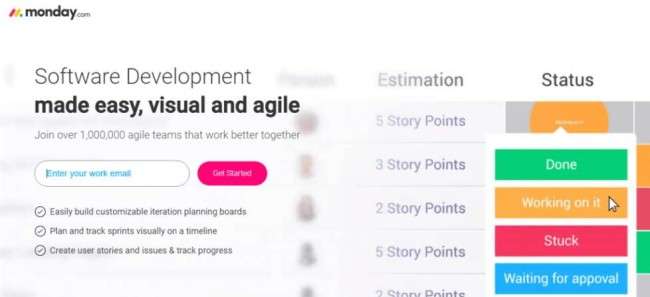
2. Azure DevOps
Microsoft’s Azure DevOps is a multi-faceted conglomerate of tools that make deployments to various team enterprises lightweight and facile.
It’s a set of “modern development services” put in use for smarter planning, better collaboration, and faster release. It lets users utilize it in its entirety or customize it in order to better respond to their workflow.
Some of the integral parts of Azure DevOps are:
- Azure Boards (primary app used for agility that makes most of Kanban boards, planning tools, traceability and reporting)
- Azure Pipelines (enables building, testing and deploying on-premises on to any cloud, can be run on different operative systems simultaneously)
- Azure Repos (code reviews, unlimited repositories free of charge, flexible hosting)
- Azure Artifacts (useful for sharing public and private sources packages with the entire team and integrating them into CI/CD in a scalable fashion)
Azure DevOps can be integrated with Slack, Timetracker, Docker, GitHub and Sentry among 1000s of extensions that can be acquired from Microsoft’s Extension Marketplace.
This agile software project tool is enterprise-ready, meaning it’s ready for the most demanding levels of reliability with 99.9 SLA and monitored by 24/7 support. Every three weeks, the producer rolls-out brand new features.
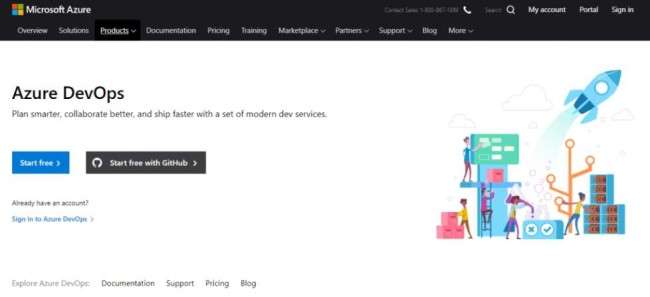
3. Asana
Agile task management solution and a cloud-based project tool, Asana makes organizing the most incremental and flexible development processes manageable and helpful.
It raises the level of communication and collaboration between departments and individuals and at the same time makes handling multiple projects effortlessly.
With Asana, planning and managing projects, tracking important points of interest and getting everyone on board and up to speed is a mission possible.
Increased clarity, accountability and reaching deadlines with projects already in the pipeline—are some of the testimonies of teams and individuals using Asana. Features such as Timeline help stay on track and within scheduled time-frames.
In the very best of agile traditions, developers can do all that and more as work evolves.
Customization of processes is made possible via templates, tracking the data with custom fields and Advanced Search reports on the criteria that matter to you and your team.
In order to improve the efficiency of agile development work, Asana creators suggest switching to Asana Premium, which requires fewer resources and is less time-consuming than the base package.

4. Smartsheet
Agile workflow’s most instrumental point is managing projects in real time. That’s where Smartsheet can come in mighty useful.
This platform for work execution provides the further ability to plan and track processes in a collaborative manner, through a wide array of project management features.
Smartsheet’s crucial appeal is in its design’s familiarity: it resembles the spreadsheet layout we all got so well accustomed to. The official website’s claim that it “aligns people with technology” sounds just like something straight out of Agile Manifesto!
Businesses and enterprises of all sizes can “move faster, drive innovation and achieve more.” How?
By scaling work fast, seamlessly connecting and integrating tools, apps and workforce! Numerous templates and pre-built features help drive the growth of developers’ projects.
The complexity of today’s businesses and software products is best matched with the simplicity and flexibility of the creative process.
Esteemed clients such as Roche, Ogilvy and PayPal have filed their testimonies in which they vouch for the success rate using Smartsheet.
And to top it all off, this agile tool can be deeply integrated with other tools and apps of the trade, letting businesses and teams of developers focus on their incremental delivery.

5. ZenHub
Although conceived to function within GitHub environment, ZenHub has quickly accelerated to the status of a standalone champion of agile software development processes.
Agile project management tool, lightweight and adaptable (much like the methodology it’s designed for), ZenHub is the ideal solution for contemporary software developers willing to deliver the best software in as expeditious a manner as possible.
By using GitHub’s data in order to keep projects en route to completion, it aims to increase the productivity of teams by bringing the very notion of project management as close to the coding as a process allows.
But it’s not limited to GitHub – ZenHub is also actionable as a browser extension or a standalone web app.
Sometimes it’s extra difficult to unearth hidden issues in the project you’re working on. Not with ZenHub, though, for its integrated reports such as Burndown Charts, Release Reports and Cumulative Flow Diagrams.
Among ZenHub's most effective solutions, agile teams will find:
- Reduced context switching
- Improved team communication
- Mastering any size project
- Automatization of workflow
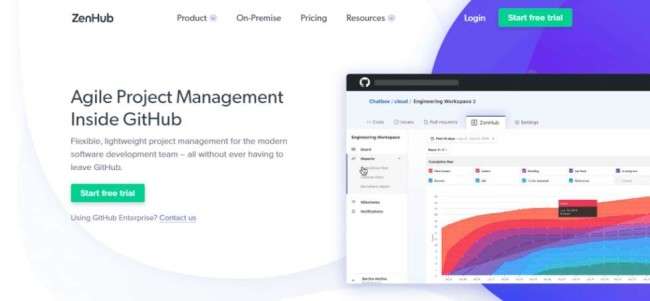
6. GitScrum
So far, we’ve covered a good deal of ground in agile software development tools that all have some common traits.
While GitScrum continues this trend of consistency and likeliness, this agile project management tool ups the ante and shows that it has some tricks up its sleeves that others don’t!
First off, it seeks to simplify even the most complex of projects—for businesses’ own good! It has a cool feature that keeps track of time for logging hours as well as another one that traces bugs and pulls a special bug report for your convenience.
Fully integrated with the likes of GitLab, GitHub, Discord, Asana, Slack and more, it features kanban boards, task management tools, burndown charts and various other reports, sharing of files among team members, task filters, discussion forums, notifications…
In its Project Menu, Agile enthusiasts will find user stories, sprints, and other agile and Scrum resources.
GitScrum offers a lifetime deal with an unlimited supply of updates. There are also Freelancer, Business and Professional packages, all coming with a different set of abilities and perks.
The official site proclaims this agile tool can answer to the needs of start-up founders, project managers, developers, freelancers, marketing teams, business operations and creatives in equal measure.
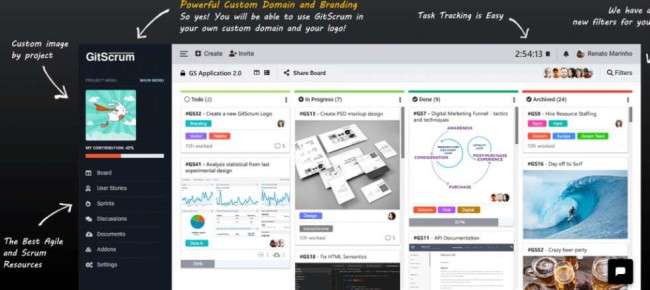
7. Sciforma
Sciforma doesn’t beat around the bush and tells you what it is right from the get-go: enterprise-centric!
This software for agile project management has a platform that excels in flexibility. It maintains the notion that effective management resources are the way to go when pursuing business objectives and growth.
With it, teams of agile software developers can deploy and execute work in one robust system that manages portfolios and resources. This can be done in several ways:
- Through status overview which identifies issues and checks the status of all projects
- Comparing multiple portfolios/options for the allocation of financial assets to maximize results
- Analysis of portfolio performance in real-time
- Management of resource assignments
- Time tracking of each task
- Identification of underused and overused resources
Also, developers can schedule projects via Gantt view and Agile project planning, controls the cost and budget of projects and manage issues by analyzing risks.
Sciforma offers a 30-day trial period for all interested parties willing to experience reduced time expenditure on reporting, improved project timelines and avoidance of expenses on non-strategic projects.
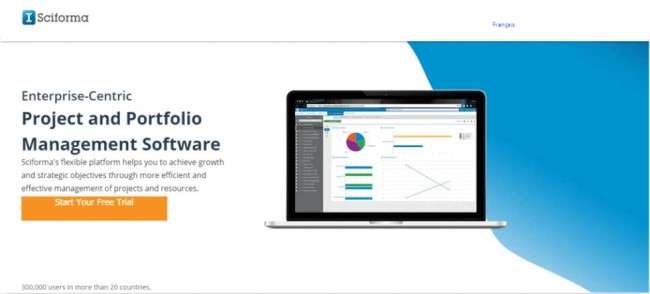
How to Apply Agile Development Principles to Your Business?
The philosophy of agility expands way beyond the realm of software development and incremental, adaptive processes thereof.
Recent trends show that agile is being at the vanguard of business aspects much closer to most people’s experiences.
These notions arose from teams working on software products. They found a place in the hearts of people who are rethinking job relations.
So, how can agile be of assistance to you and your business?
As a way of improving productivity and quality of work—much of IT/software departments’ agile framework is applicable to these three areas:
- Product management
- Lean portfolio management
- Human resources
According to a study published on TechBeacon, organizations can follow the exact same agile principles as software development to optimize their productivity.
Globe-wide, as many as 166 companies from 29 countries responded to a survey. This helped reveal a roll-out of these new models.
Some of the benefits of agile business reform reported in the survey were: bigger satisfaction of both employees and customers, better market performance and overall superior working procedures.
The bottom line of the study is that to achieve business agility, the entire enterprise needs to undergo something of a paradigm shift. “The change of mindset” can affect the organization in ways unparalleled.
To understand what your clients value and how to get proper feedback from them, we advise you to skim through our extensive database of software development companies and ask for feedback from them.
Also, in relation to agile software development, getting acquainted with the advantages of custom processes is advised.
Pros and Cons of Agile Software Development
Agile software development may come with the following advantages and disadvantages.
Pros
- Focus on fast and timely delivery
- Adaptability to changes
- Collaborative nature
- Quick feedback loop for performance enhancement
- Transparency about issues and process improvement
- Continuous improvement with a direct effect on the next product or phase
Cons
- Difficulties in management style
- Multiple, shifting goals at once
- Slower documentation
FAQs
What are some agile software development examples?
Some of the most common examples of Agile development are Scrum, Kanban, Extreme Programming (XP), Lean Development and Crystal.
What are some agile metrics I can use for reporting?
Here are some of the powerful Agile metrics:
- Sprint Burndown visualization chart highlighting completed points during a phase
- Agile velocity measuring the number of points completed and predicting the output in the next sprints
- Lead time measuring the time allocated for every sprint
- Code coverage evaluating the percentage of code covered during each unit test
- Cumulative flow visually shows the status of the task
How does Agile relate to DevOps?
Agile plays a vital role in DevOps in that the methodology helps bridge the gap between the client and the software development team.
Agile helps improve collaboration and communication between the product owner, operations teams and stakeholders, ensuring immediate implementation of feedback and timely delivery of reliable software.









